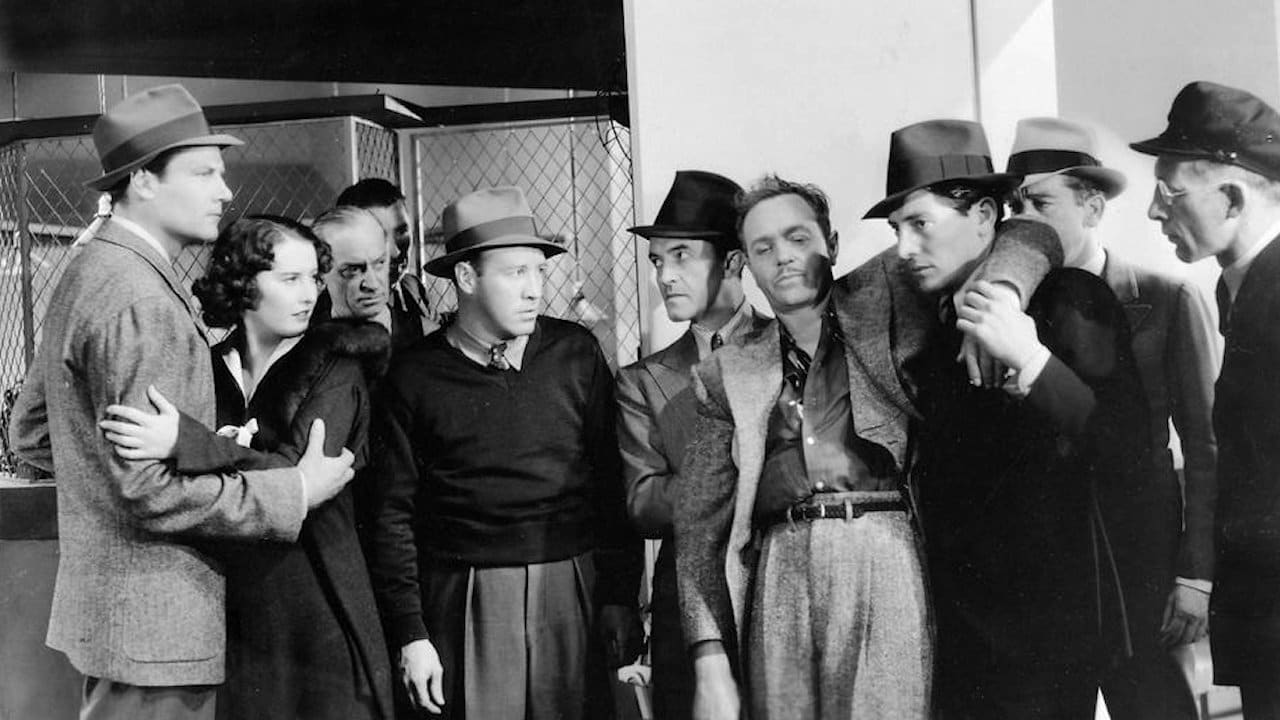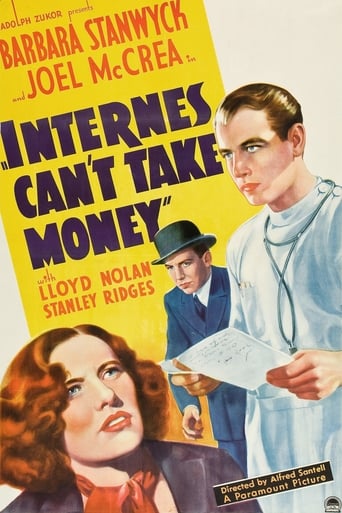

Barbara Stanwyck (Janet Haley), Joel McCrea (Jimmie Kildare), Lloyd Nolan (Hanlon), Stanley Ridges (Innes), Gaylord Pendleton (Interne Jones), Lee Bowman (Interne Weeks), Irving Bacon (Jeff), Barry Macollum (Stoolie Martin), Pierre Watkin (Dr Pearson), Harry Tyler (chief clerk), Charles Lane (Grote), James Bush (Haines), Fay Holden (Mother Teresa), Frank Bruno (Eddie), Anthony Nace (Dr Riley), Nick Lukats (interne), Jack Mulhall (mug), George Lynn (Joe), John "Skins" Miller (Weasel), Elmer Jerome (Wipey), Priscilla Lawson (nurse).Directed by ALFRED SANTELL (in the words of John T. McManus) "with a blend of Hitchcock-like suspense and typically American verve." Screenplay: Rian James, Theodore Reeves. Based on a short story by Max Brand. Photography: Theodor Sparkuhl. Art directors: Hans Dreier and Roland Anderson. Set decorator: A.E. Freudeman. Film editor: Doane Harrison. Costumes designed by Travis Banton. Music director: Boris Morros. Assistant director: Roland Asher. Sound recording: Harry Lindgren, Louis Mesenkop. Producer: Ben Glazer. Copyright 16 April 1937 by Paramount Pictures, Inc. New York opening at the Paramount: 5 May 1937. Sydney opening at the Prince Edward as a support to Go West, Young Man: 17 July 1937. 78 minutes. COMMENT: Believe it or not, this is actually the first of the Kildare films. Of course Kildare fans will miss all the regular characters at Blair General Hospital (called Mountview Hospital here), the only familiar figure being Kildare himself. There is no Dr Gillespie. The head of the hospital here is a Dr. Pearson who bears no relation at all to kindly Dr. Carew. Joel McCrea's Kildare, however, is the same character as that essayed by Lew Ayres; and the plot is the same kind of simplistic short story that tends to stretch mighty thin over a feature-length film which is long on dialogue and short on action.Nonetheless, Alfred Santell's inventive direction manages to stir up audience interest, particularly in the first half-hour. In fact he sets the tone for his subsequent technique right from the very opening shot — an extremely long take from a dolly in which the camera darts in and out of cubicles where patients are being treated. When Stanwyck enters, he uses a very low angle tracking shot and the menace inherent in her whispered and elliptic conversation with Stanley Ridges is effectively put across by using a variety of angles combined with atmospheric lighting.Stanwyck fits the role the screenplay requires like a glove. While her close-ups are attractive, however, her fans will be disappointed that her clothes are deliberately shabby. Combined with the large hat she wears to conceal her features, her wardrobe most successfully imparts an air of mystery and concealment.Other roles are capably cast. Lee Bowman makes some impression, despite the brevity of his part; and Lloyd Nolan does his best to make his unbelievable character more credible. However, Irving Bacon steals the also-ran acting honors with his portrayal of a shady, one-eyed bartender.
... View MoreThe first appearance of young James Kildare, MD was in this Paramount feature that starred Joel McCrea as the young Intern at Blair General Hospital. Come to think of it, I don't recall if the name of the hospital is given in the film.Nor will you find any of the other regulars from the Kildare/Gillespie series from MGM. When Paramount saw no possibilities in a series of films, they didn't do film series with the exception of Hopalong Cassidy, MGM picked it up.Lew Ayres who was Kildare over at MGM was a bright idealistic getting his minting over at Blair General Hospital under the tutelage of gruff but kindly Lionel Barrymore. McCrea is a more stern type of Kildare, the most straight arrow of straight arrows. In fact Joel McCrea was quoted as saying he never felt comfortable being anything other than the straight arrow hero. But he was good in those parts.His patients include Barbara Stanwyck, a woman from the wrong side of the tracks who will do anything to get back the child she lost custody of and Lloyd Nolan who he patches up after a brawl in the bar they both frequent. Both of their stories intertwine and you see the film to learn how.In what was essentially a B programmer Paramount gave a lot of good production values to this film. I guess it was befitting the stars McCrea and Stanwyck who were definitely on their way up.I do sort of miss the Blair General Hospital regulars, but McCrea does right by the character of James Kildare, MD.
... View MoreAside from the archaic spelling of "interns", this Paramount feature is notable for Joel McCrea as an, er, intern in a New York City hospital. Well, not for that really, but for the fact that McCrea's doctor happens to be named "Kildare". Yes, this is where it all began for the series that would make so much money for MGM a couple of years later. There's no Dr. Gillespie here. A deskbound bureaucrat shows up early to lecture Kildare on trying a new surgical procedure without permission, even delivering the immortal line, "I'd remind you this is a hospital[, and not an experimental laboratory". (Was this the first appearance of that line? It would go on to a nice career in medical dramas, and Carl Reiner's delivery of it in a spoof on Sid Caesar's show in the '50s is one of the funniest things I've ever heard.) Of course we know before the picture is over Kildare will have to use that very procedure to save someone's life.Aside from no Gillespie-figure, ICTM is also missing the Hardy Family ambiance of the MGM Kildares. The atmosphere here is much closer to Dead End. In fact those expecting a typical Kildare will be surprised at how noirish Theodor Sparkuhl's cinematography is -- L.B. would never have allowed this many shadows. Especially eye-catching is Sparkuhl's lighting of Hans Dreier's art deco clinic set, although we really only see it at the beginning. I've never been terribly impressed by director Al Santell (though if you want to read a heartwarming story about him, check out Niven's The Moon's A Balloon), but he was clearly inspired by Dreier's clinic set, opening the film with some flowing tracking shots.There seems to be one more thing I wanted to mention... Oh yeah -- the female lead is played by no less a personage than Barbara Stanwyck. Indeed, despite the title most of this is not really a hospital drama, but a Stella Dallas soaper about Stanwyck trying to find her lost daughter. After the opening McCrea disappears for several reels as we follow Babs in her search (including a tearjerking scene at an orphanage). This being the '30s she naturally gets involved with gangsters, including Lloyd Nolan (despite his third billing he only really shows up in the last act) and sleazy Stanley Ridges, who steals all his scenes with Stanwyck -- she couldn't have been terribly happy about that -- as the scumbag who agrees to find the kid in exchange for certain favors from Babs.A B picture story curiously given A picture production and stars, Internes Can't Take Money (and who is responsible for that terrible title?) deserves to better known than as just Kildare The First. In fact, while watching the film with its shadowy photography, evocative sets, and moody prenoir atmosphere, the Kildare pedigree is one of the least interesting things about it.
... View MoreThis film appears to take place somewhere after the first "Dr. Kildare" movie at MGM which established James Kildare as a recently graduated medical student chosen by the gruff Dr. Gillespie (Lionel Barrymore) to be his assistant. The grumpy elderly doctor isn't there, neither is the stern but goodhearted nurse played by Alma Kruger, her assistant played by Laraine Day, and most missed, the wise-cracking receptionist played by Marie Blake. But, this is obviously New York City, late 30's, and Gillespie is already a hard-working intern, who is seen in an early scene defending a fellow intern about to be fired. He takes care of a burn victim (Barbara Stanwyck), and is drawn (as he would be in the MGM series as played by Lew Ayres) into her scandalous past which has her as the widow of a bank robber who had her baby taken away from her when she went to prison, wrongly accused of being a part of the dead husband's criminal activities. Now out of prison, Stanwyck needs $1000 to get information as to the whereabouts of her baby, and gets help from Kildare who is probably the biggest hearted intern ever to step foot into a New York City hospital.In the short 78 minutes that this medical drama takes to unravel, there is a lot of filler, but most of it is simple slice of life drama with dollops of humour. One intern is seen telling an overweight socialite to exercise, and suggests starting by pulling herself away from the dining table, while later, another matron is told when asked how to take care of sea sickness that when it happens, she'll know what to do. Kildare breaks medical laws by treating gangster Lloyd Nolan's stab wound, finds himself paid off, which leads to a dramatic scene where Stanwyck tries to get the money from him so she can pay the crooked lawyer to find her baby. Stanwyck, already a huge star by the time this came out, admirably took on this "B" picture and comes off quite nicely. She is more the focus than McCrea's noble Kildare is, although if anyone was going to play him other than Lew Ayres, McCrea would be it. Such other well-known character actors as Charles Lane and an eye-patched Irving Bacon have nice cameos, and "Ma Hardy" herself (Fay Holden) appears briefly as the kind-hearted nun whom Stanwyck consults to find her child. Overall, an entertaining "B" melodrama that may not be as remembered as the MGM series which followed (and the much later TV series), but is definitely worth including in the study of this series, and for the presence of its major stars who were an excellent on-screen team in several films.
... View More